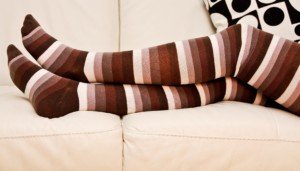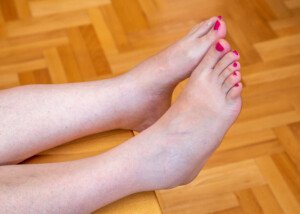
Is it edema when you roll down your tight socks and see that big indent in your leg?
“I have a memory of my grandmother, who used an elastic band to hold up her stockings,” begins Marc I. Leavey, MD, a primary care physician with 40-plus years of experience.
“At the end of the day, when she would roll them down, there was a clear groove in her leg above slightly swollen calves.
It turns out that blood pumped down to the legs requires the relatively weak pumping action of calf muscles to return that blood to the circulation.
“External compression on surface veins can cause that blood, and another body fluid called lymph, to stagnate in the legs.
“This produces the surface irregularities that mirror the constricting devices that had been used on the legs.
“These days, tight socks can do the same thing, as can about anything else that impedes the circulation.
“Avoiding such constriction, walking around a bit to get those body fluids back in circulation, and even elevating the legs once freed of constraints all help to obliterate those nasty lines.”
If only your tight socks are causing edema, you have nothing to worry about.
However, you may already have edema that’s being caused by a medical problem or lifestyle habit, and the tight socks are simply making this fluid buildup more noticeable or aggravating it.
Lay off the tight socks to see if it disappears. If not, you need to find out why this swelling is occurring.
Common Causes of Edema
- Heart Failure: When the heart struggles to pump blood efficiently, fluid can accumulate in the legs.
- Kidney Problems: Conditions affecting the kidneys can impair the body’s ability to manage fluid balance, leading to swelling.
- Liver Disease: Liver conditions like cirrhosis can disrupt normal fluid balance and lead to fluid retention in the legs.
- Venous Insufficiency: Poor circulation in the veins, often due to damaged or weakened vein walls or valves, can cause blood to pool in the legs, causing swelling.
- Medication Side Effects: Certain medications can puff up the legs.
- Pregnancy: Increased blood volume and pressure on the veins from the growing uterus can lead to swelling in the legs, especially later in pregnancy.
- Infections: Infections in the leg can cause swelling along with redness, pain and warmth.
- Lymphedema: A condition where the lymphatic system is damaged or obstructed, leading to fluid buildup in the tissues of the legs.
- Menstruation: One’s period can lead to a puffiness in the feet that may extend a little bit above the ankle.
- Poor Diet: High salt intake can cause fluid retention, leading to swelling in the legs.
Again, if you’re worried, avoid wearing tight socks or any socks, for that matter, and see what happens over the next several days.














